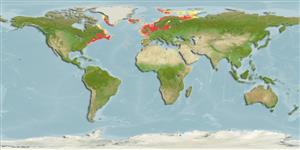Classification / Names
Common names from other countries
Main reference
Size / Weight / Age
Max length : 45.0 cm SL male/unsexed; (Ref. 37032); common length : 30.0 cm SL male/unsexed; (Ref. 37032); max. published weight: 1.1 kg (Ref. 6114); max. reported age: 25 years (Ref. 89560)
Length at first maturity
Lm 16.7 range ? - ? cm
Environment
Marine; brackish; benthopelagic; oceanodromous (Ref. 51243); depth range 0 - 364 m (Ref. 58426), usually 0 - 200 m (Ref. 6683)
Climate / Range
Temperate; 1°C - 18°C (Ref. 188), preferred 8°C (Ref. 107945); 80°N - 33°N, 79°W - 70°E
Distribution
North Atlantic: in the west, it ranges from southwestern Greenland and Labrador southward to South Carolina, USA. In the east, it ranges from Iceland and southern Greenland southward to the northern Bay of Biscay and eastward to Spitsbergen and Novaya Zemlya in Russia, including the Baltic Sea (Ref. 188).
Countries | FAO areas | Ecosystems | Occurrences | Introductions
Short description
Dorsal
spines
(total): 0;
Dorsal
soft rays
(total): 13-21;
Anal
spines: 0;
Anal
soft rays: 12 - 23;
Vertebrae: 51 - 60. Slender fish with a round belly. Scutes without prominent keel; 12 to 16 post-pelvic scutes (Ref. 188). No median notch in upper jaw; operculum without radiating bony striae; the posterior border of its gill opening is evenly rounded. It is blue to greenish-blue dorsally, becoming silvery ventrally. No distinctive dark spots on the body or fins (Ref. 188).
IUCN Red List Status (Ref. 115185)
Threat to humans
Harmless
Human uses
Fisheries: highly commercial; gamefish: yes
Tools
Special reports
Download XML
Internet sources
Estimates of some properties based on models
Phylogenetic diversity index
PD50 = 0.6250 many relatives (e.g. carps) 0.5 - 2.0 few relatives (e.g. lungfishes)
Trophic Level
3.4 ±0.1 se; Based on diet studies.
Resilience
Medium, minimum population doubling time 1.4 - 4.4 years (rm=0.1-0.5; K=0.2-0.6; tm=2-5; tmax=25; Fec=17,300-301,000)
Vulnerability
Moderate vulnerability (39 of 100)
Price category
